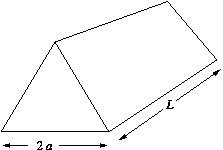Let's take this in two parts:
- How do we pick slices?
We can come up with some basic rules for this:
- If we're finding volumes, if possible pick slices so that
each slice has a nice shape---a circle, rectangle or
triangle, for example. If possible, pick slices that
don't change in size or shape at different places in the
figure.
- If we're finding mass or work (or something else), pick
slices so that each slice has a constant density or work
(or the other thing).
Consider the shape shown below
 To find its volume, rule (i) says slice it vertically to get
triangular slices---that don't even change as we move the slices
along the tube. To find mass, rule (ii) says slice it so that
the density at each point on the the slice is constant. So, if
the density changes from front to back, we would use the
vertical, triangular slices, while if it changes from top to
bottom, we would use horizontal, rectangular slices. This
problem is worked out in
another clarification
To find its volume, rule (i) says slice it vertically to get
triangular slices---that don't even change as we move the slices
along the tube. To find mass, rule (ii) says slice it so that
the density at each point on the the slice is constant. So, if
the density changes from front to back, we would use the
vertical, triangular slices, while if it changes from top to
bottom, we would use horizontal, rectangular slices. This
problem is worked out in
another clarification
- How can we be sure that we're getting the right
equation for the volume/mass/work for the slice?
Let's break this into three different parts
- If we're finding volumes, our slices will inevitably have
a volume given by
volume = (cross-sectional area) (thickness)
The cross-sectional area will be an equation for the area
of a circle, triangle, or rectangle (we hope), and should
always have something like an x2 in it -- so that it
will have units of (length)2. The thickness will always
be something like dx.
- Then all we have to remember is that
- area of a circle = pi r2
area of a triangle = (0.5) b h
area of a rectangle = L w
And we have to figure out what the r, b,
h, L and w are for our particular
figure by looking at what we know about the figure.
- If we're finding a mass, then each slice has a mass given
by
mass = (density) (volume),
where the density should be given to us (or be "obvious,"
like the density for water) and the volume is calculated
in a matter similar to the above.
- If we're finding the work to do something to the object,
than each slice has a requisite work given by
work = (force) (distance),
where the force is almost always the weight of the slice,
which is
force = weight = (mass) (g) = (density) (volume) (g)
(and we can omit the g if we are working with a
density that gives weight per unit volume, e.g., in
pounds).
If we're working with a two-dimensional figure, then
all references to "area" above become references to "length",
and all references to "volume" become references to "area".
